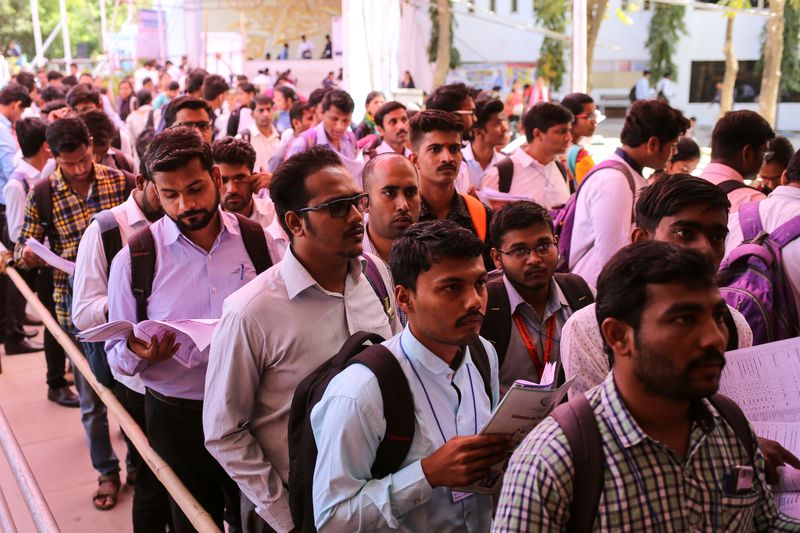Government Responds to Claims of Inaccuracy in Official Jobless Data

The recent Reuters article dated July 22, 2025, raises doubts about the accuracy of India’s official unemployment statistics, relying heavily on a perception-based survey of approximately 50 unnamed economists. This narrative contradicts robust and credible data from the Periodic Labour Force Survey (PLFS), which is recognized for its methodological rigor and transparency. The article’s reliance on expert opinions without substantial empirical backing has sparked concerns regarding the reliability of its conclusions, particularly in light of the positive trends indicated by official employment data.
Concerns Over Methodology
The Reuters article’s foundation rests on expert opinions rather than verifiable data, raising significant questions about its methodological rigor. The lack of transparency regarding the economists involved, their selection criteria, and whether they represent a diverse cross-section of analysts introduces potential biases. Furthermore, the article does not provide details on the survey’s structure, the metrics used, or the standards for interpreting the data, which undermines the credibility of its conclusions. Without information on sampling variability or statistical significance, the article’s claims about India’s employment scenario appear unfounded.
In contrast, the PLFS, conducted by the National Statistical Office (NSO), is a globally recognized source of employment data in India. It employs a large-scale, stratified, multi-stage random sampling framework that encompasses both rural and urban areas. Since January 2025, the PLFS has begun generating monthly estimates, enhancing its ability to track labor market trends in real time. Its methodology aligns with international standards set by organizations like the International Labour Organization (ILO), ensuring that its data collection and reporting practices are consistent with global norms.
Current Employment Trends
According to the latest PLFS data, the Labour Force Participation Rate (LFPR) for individuals aged 15 and above has risen from 49.8% in 2017-18 to 60.1% in 2023-24. Concurrently, the Worker Population Ratio (WPR) has increased from 46.8% to 58.2%, while the Unemployment Rate (UR) has significantly decreased from 6.0% to 3.2%. These indicators suggest a greater absorption of the workforce into productive employment. Notably, youth unemployment has dropped from 17.8% to 10.2%, which is lower than the global average of 13.3%, as reported by the ILO.
The Reserve Bank of India’s KLEMS database further corroborates these positive employment trends, indicating that total employment in India has grown from 47.5 crore in 2017-18 to 64.33 crore in 2023-24, adding 16.83 crore jobs over six years. Formal employment is also on the rise, with over 1.29 crore net subscribers added to the Employees’ Provident Fund Organization (EPFO) in 2024-25, compared to just 61.12 lakh in 2018-19. This growth reflects a strengthened formal workforce and improved social protection coverage.
Government Initiatives and Future Prospects
The Indian government has implemented various initiatives aimed at boosting employment, including Skill India, Digital India, and the National Education Policy (NEP) 2020. These programs have significantly increased graduate employability, rising from 33.95% in 2013 to 54.81% in 2024, according to the India Skills Report. Additionally, the new ₹99,446 crore Employment Linked Incentive (ELI) Scheme aims to create 3.5 crore jobs, particularly in the manufacturing sector.
The government has also introduced several schemes to generate both direct and indirect employment, such as the Mahatma Gandhi National Rural Employment Guarantee Scheme (MGNREGS) and the Pradhan Mantri Employment Generation Programme (PMEGP). These efforts, combined with record capital expenditure, are diversifying job opportunities across various sectors, including startups and the gig economy. The ongoing cultivation of India’s demographic dividend through targeted initiatives is expected to bridge the gap between education and employment, further enhancing job growth in emerging sectors.
Observer Voice is the one stop site for National, International news, Sports, Editor’s Choice, Art/culture contents, Quotes and much more. We also cover historical contents. Historical contents includes World History, Indian History, and what happened today. The website also covers Entertainment across the India and World.

